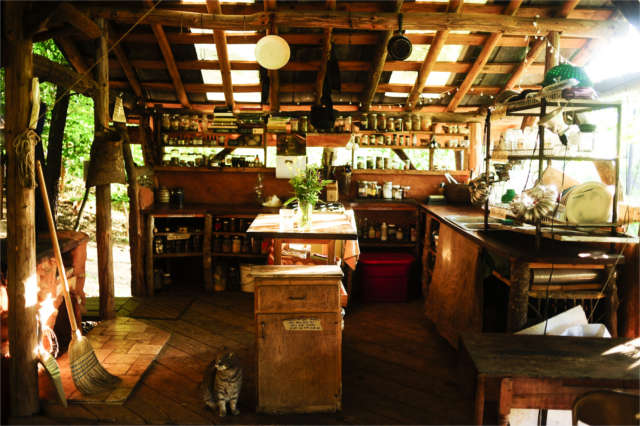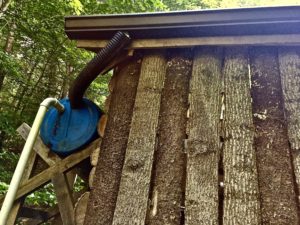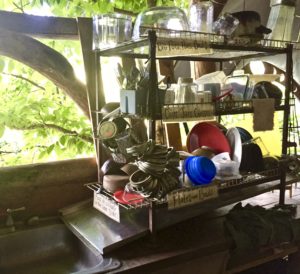A few simple, creative outdoor kitchen ideas will help you put together a lovely, functional space for food prep close to your home. Cooking outdoors isn’t just for camping trips. Creating an outdoor kitchen gets you outside every day, even during “ordinary” life. You’ll enjoy the beauty of the season and connect with the birds, plants, winds and weather as you prepare your meals.
Whether you live in a tiny house or a more traditional building, moving the kitchen outside during the warm season will free up indoor space. Another perk of having an outdoor kitchen is that the heat from your stove or oven won’t get trapped inside and cook you in the summer months! There are lots of benefits to having an outdoor kitchen.
Affordable Outdoor Kitchens
Now, if you search for outdoor kitchen ideas, you’re going to find lots of beautiful, fancy, and relatively pricey examples and ideas. That’s not what we’re going for here. Not that we don’t think these upscale outdoor kitchens are cool and pretty; many of them are. It’s just that we’re more interested in simple, practical, functional ideas that anyone can manifest, even with limited money or space. Also, we’ve got our minds on outdoor kitchen ideas like ecological water systems and renewable energy. So, if that’s your jam, too, read on.
Outdoor Kitchen Idea #1: Rainwater catchment for washing
A kitchen sink with running water is pretty awesome and useful. Utilizing natural resources in the lowest-input, most efficient way is cool, too. That’s why we love permaculture-inspired, small-scale rainwater catchment systems in outdoor kitchens to provide pressurized water to the kitchen sink.
Think about it: When rain falls on the roof of your outdoor kitchen, it’s gotta go somewhere. You can either deal proactively with whatever runs off the roof, or you’ll have a muddy mess on your hands. Might as well catch all that water in a tank that is elevated above sink height. Then, you simply plumb that tank into your faucet, and voila! Rainwater turns into washing water, with no muddy moat around your kitchen and no need to pump up groundwater.
You may be able to fill a large tank on the ground, slightly uphill of your sink. Or, it might make sense to place a tank on a pedestal. It all depends on your unique topography and circumstances. If you want to learn more about rainwater harvesting, join Wild Abundance for our Permaculture Design Course in September. We teach the details of how to set up a system like this.
Outdoor Kitchen Idea #2: Solar Oven
There’s something deeply satisfying about cooking without burning fossil fuel. Solar ovens are a time-tested and super simple technology that harness the energy of the sun to bake your food. No matter what kind of house you live in, you’re probably not excited about turning on the oven in the summer on a sunny day. But this especially applies to tiny houses.
Basically, solar ovens are like tiny greenhouses. They have reflective surfaces that concentrate the sun’s rays into a dark-colored box with a glass lid. If you live in a very shady place, a solar oven isn’t for you. But if you’ve got a fair amount of sun exposure, it can be used any day that isn’t cloudy or rainy (even in the winter).
This outdoor kitchen idea is very accessible. You’ll find lots of plans online for DIY solar ovens. All you need is a cardboard box, some aluminum foil, a piece of glass, and a few other odds and ends. If you’re sure you want to add this carbon-neutral cooking method to your outdoor kitchen, various prefabricated solar ovens are available. The Sun Oven brand is one that we use and really like. It’s lightweight, durable and even made in the USA. Plus, it’s got a simple and effective locater that helps you find the perfect angle for best solar exposure.
Outdoor Kitchen Idea #3: Critter-proof food storage
A big challenge for many folks with outdoor kitchens is keeping critters out of foodstuffs. While cooking outdoors is lovely, being that close to nature means contending with other creatures that are also hungry. It’s a fabulous idea to build beautiful wooden cabinets with tight-fitting doors that latch to keep food safe. But in our experience, small rodents are very motivated, very clever, very persistent, and very tiny. Insects are even tinier. They can find their way into cabinets that seem tight to you and me. What’s more, building cabinets with tight-fitting doors requires carpentry skills that not everyone has. We don’t want that to get in the way of everyone enjoying an outdoor kitchen.
In general we aren’t huge fans of plastic stuff, but it does have its place. For example, consider food-grade plastic buckets for your outdoor kitchen pantry. Even though these buckets are pretty affordable and accessible, the lids that come with them are a royal pain in the rear to open and close. For a simple solution that makes retrieving food from buckets really easy, check out Gamma Seal Lids. They’re lids that screw on and off of buckets, and as far as we can tell, they’re critter-proof. Watch out though, they’re not toddler-proof!
If you’ve got a fridge in your outdoor kitchen, it’s likely that your cold food is safe from mice, rats and insects. Where there are courageous raccoons, however, it’s worth latching your fridge. Their little paws are extremely dexterous and a regular fridge door is no deterrent to their hunger and mischief.
Outdoor Kitchen Idea #4: The Rocket Stove


Cooking with wood is quintessential to outdoor living, Yet fire pits can be smoky and sooty. Plus it takes a lot of wood and a long time to get the right coal bed for cooking. With a rocket stove, you can use wood as your fuel – but in a much more efficient way.
Simply put, a rocket stove is a type of cooker designed to burn small-diameter wood extremely efficiently. It consists of a combustion chamber with specific air inflow and an insulated chimney. In trials conducted by the Aprovecho Research Center, these puppies reduced the need for fuel wood by up to 30%. In addition, they decreased harmful particulate emissions that can irritate lungs. They heat up quickly and, depending on the design, may not even leave soot on your pots and pans.
Rocket stoves are fairly simple to build yourself, with designs available online. Aprovecho has some really good ones that are tried and true. Commercial rocket stoves are also available. This is probably the most bang for your buck, so to speak, of these outdoor kitchen ideas in terms of ecological impact and simplicity.
Outdoor Kitchen Idea #5: Dish-drying “cabinet”
This outdoor kitchen idea is great for indoors, too. And it’s so simple and efficient that you may be thinking “duh!” as soon as you hear about it.
Have you ever had the experience of needing to do some dishes and finding the dish rack full of dry dishes that you just don’t feel like putting away first? You’ve already washed them, for goodness’ sake, so why do you need to deal with them again before using them? Well, this problem disappears when you build a drying rack that doubles as a cabinet. With this idea you’ll save time and space in your outdoor kitchen (or tiny house kitchen, or regular kitchen). Just make sure that you direct the flow of water dripping from your dishes into the sink or another appropriate place.
We can’t take credit for this brilliant (and somewhat obvious) idea. In fact, these hybrid dish-drying and storage cabinets are commonplace in Finland. There’s even a word for them in Finnish: astiankuivauskaappi. You’ll sound really cool if you use that word when you’re showing off your outdoor kitchen, if you can only figure out how to pronounce it!
To learn more elegant and sustainable ideas for your outdoor kitchen and beyond, check out the Wild Abundance Natural Building and Tiny House Workshop or Online Tiny House Building Class. It’s an 8-day adventure in practical, natural building, tiny house design and construction, and using systems-thinking to design our structures and living spaces.
To explore more simple, fun, ecological outdoor kitchen ideas, like homemade smokers and barbecues, check out this blog from our friends at Poly Tunnels: DIY Outdoors Kitchen Ideas (they’re British, so they say “outdoors” instead of outdoor).







